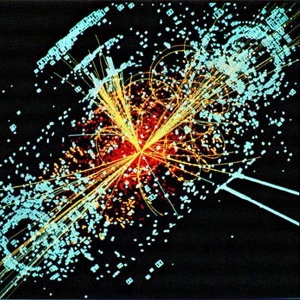Sep 11 2008
Dozens of MIT physicists are waiting anxiously to sift through data from the world's biggest physics experiment, which officially started today when scientists sent the first beam of protons zooming at nearly the speed of light around the 17-mile Large Hadron Collider near Geneva, Switzerland.
 The compact muon solenoid (CMS) experiment at CERN's Large Hadron Collider will look for the Higgs boson, shown here in simulation. Image / CERN
The compact muon solenoid (CMS) experiment at CERN's Large Hadron Collider will look for the Higgs boson, shown here in simulation. Image / CERN
Some 40 MIT researchers are among the thousands of physicists from around the world collaborating on the LHC, the world's most powerful particle accelerator. MIT has the largest American university group working on one of the collider's four detectors, known as the CMS (compact muon solenoid) detector, and a smaller group working on another LHC detector known as ATLAS (a toroidal LHC apparatus).
The first circulating beam is a major accomplishment on the way to the ultimate goal: high-energy beams colliding in the centers of the LHC's particle detectors. Scientists participating in these experiments will analyze the collisions in search of extraordinary discoveries about the nature of the physical universe. Beyond revealing a new world of unknown particles, the LHC experiments could explain why those particles exist and behave as they do. They could reveal the origins of mass, shed light on dark matter, uncover hidden symmetries of the universe and possibly find extra dimensions of space.
"The start of the LHC culminates about 20 years of design and construction work. The accelerator and the experiments are ready to go. We expect LHC data to arrive on MIT campus very shortly," says MIT Professor Bolek Wyslouch of the CMS group. "We hope to see new particles and new processes that may explain probably the most fundamental properties of matter."
For physicists, the excitement about the first beam event is unparalleled. "For much of my career, starting in the early 70's, the standard model of high-energy physics has worked marvelously well but some of its foundations still remained untested," says MIT physicist Frank Taylor, the U.S. ATLAS muon project leader. "Theoretical physicists have been very creative over the last three and a half decades with many beautiful ideas which are mathematically consistent but may not represent nature. Now we have an instrument to check these theories and perhaps to find something not even dreamed of. We're very excited!"
Added Professor Steven Nahn, another member of the CMS team, "The LHC represents the first opportunity in a long time to both close the chapter on the prevailing model of how our world works on the most fundamental levels, and, at the same time, perhaps start a whole new chapter. I feel like I'm Vasco de Balboa seeing the Pacific for the first time -- a whole new ocean out there -- not sure how big it is or what it contains, but it is certainly worth exploring."
Other MIT members of the CMS team are Associate Professors Christoph Paus and Gunther Roland, Professor Wit Busza and senior research scientist George Stephans.
The LHC is operated by the European Organization for Nuclear Research (CERN). The accelerator is located on the outskirts of Geneva near the French border, lying below farmland at depths ranging from 60 to 120 meters.